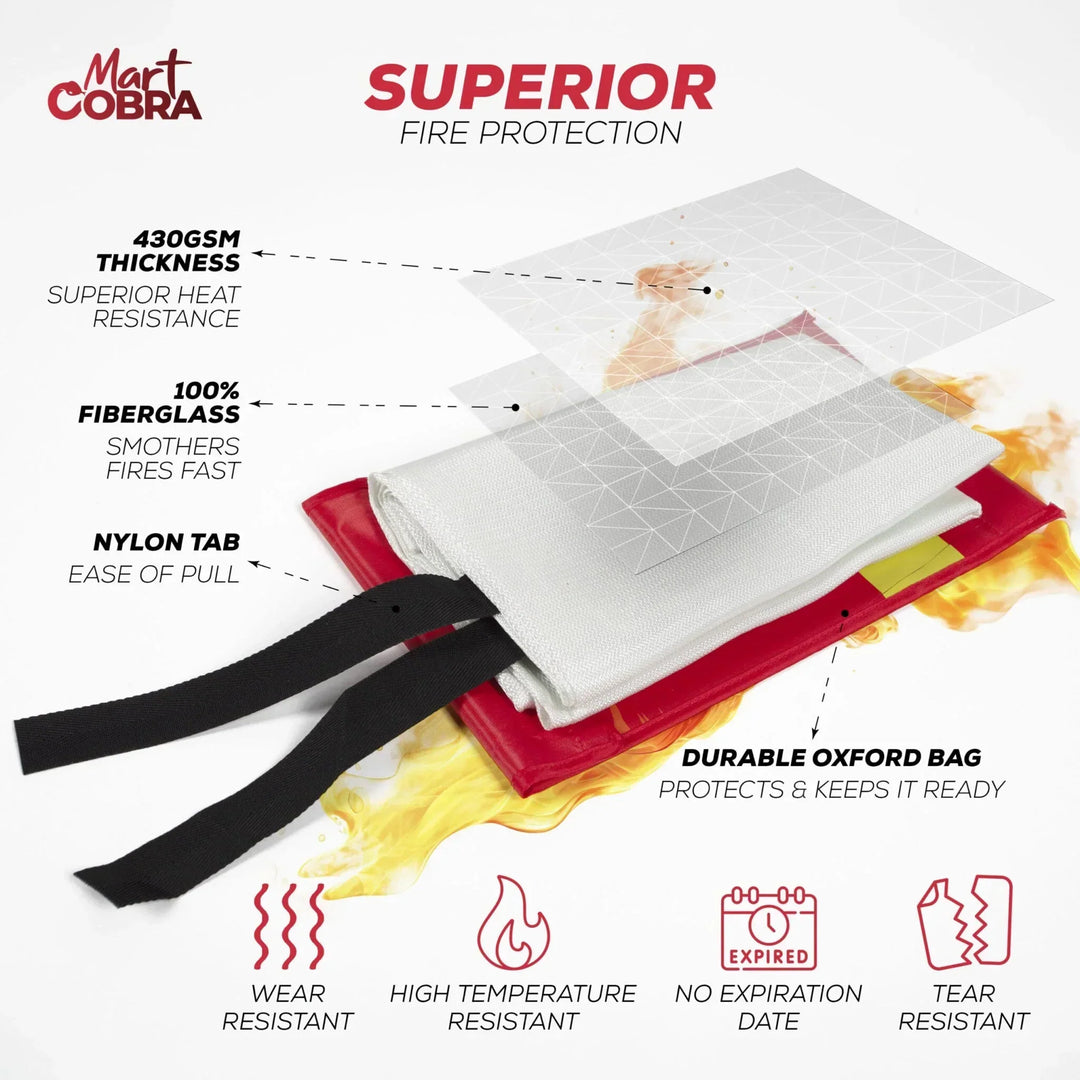When you consider fire safety measures for either your home or commercial setting, fire blankets are an essential tool in your arsenal. These blankets are designed to smother small fires by cutting off the oxygen supply, effectively preventing the fire from spreading. The materials they are made from are crucial for their effectiveness and safety. In the past, asbestos was commonly used in fire blankets due to its excellent heat-resistant properties.
However, the discovery of asbestos's health risks has led to increased regulations and a significant decline in its use. Asbestos is a hazardous material that can cause serious diseases, including mesothelioma and lung cancer, when its fibers are inhaled. It's critical for you to understand the composition of fire blankets, especially if they are older models, as they could contain asbestos. Presently, fire blankets are usually constructed from materials like fiberglass or treated wool, which are safe and do not pose the health risks associated with asbestos exposure.
For industry professionals and homeowners alike, ensuring the safety of fire suppression tools is non-negotiable. If you're uncertain whether your fire blanket contains asbestos, it is wise to check the product manual or consult with a professional for guidance on safe handling or disposal. Remember, current fire blankets are designed to be safe and effective for use without the dangers associated with asbestos.
Composition of Fire Blankets
When you consider a fire blanket for your safety needs, understanding what materials are used and their history is crucial. Let's examine the specific composition and historical aspects of these vital safety tools.

Materials Used in Fire Blankets
Fire blankets are designed to smother fires, providing a swift and effective means of extinguishing flames. The principal materials utilized in these products include fiberglass,wool, andsilica.Fiberglass, crafted from fine fibers of glass, is widely recognized for its heat resistance and strength.Wool is another material prized for its natural fire-retardant properties.Silica, an incredibly heat-resistant material, can withstand extreme temperatures, making it an ideal component in the structure of fire blankets designed for intense heat exposure.
Historical Use of Asbestos in Fire Blankets
Asbestos fire blankets, once common due to the natural heat resistance of asbestos fibers, are now recognized as hazardous. Historically, the inherent properties ofasbestos fibers made them a preferred choice until it was discovered that these fibers could become airborne and pose serious health risks. If you come across older fire blankets, they may contain asbestos, and it's important to handle them with care or have them professionally assessed and disposed of if necessary. Today's fire blankets, however, do not contain asbestos, ensuring your safety from this toxic material.
Health and Safety Concerns
When dealing with materials in fire blankets, understanding associated health risks and compliance with safety regulations is imperative. Asbestos, historically used in fire blankets, can pose serious health hazards when fibers are airborne.
Risks of Asbestos Exposure
Exposure to asbestos can lead to severe health conditions includingmesothelioma, a malignant tumor,asbestosis, a chronic lung disease, and other forms oflung cancer. If you've handled old fire blankets, your risk of developing anasbestos-related disease may be elevated due to the release of tiny, invisible fibers that can be inhaled or ingested. The latency period for these diseases can be several decades, indicating that symptoms may not become apparent until many years after the initial exposure.
Occupational Safety for Workers
If your occupation involves handling fire blankets or materials suspected of containing asbestos, it is your right to work in an environment where your health is not compromised.OSHA mandates strict guidelines to minimizeasbestos risk in the workplace. You are entitled to proper respiratory protection, training, and equipment provided by employers to prevent inhalation of hazardous fibers.
Regulations and Asbestos Abatement
Abiding by bothEPA andOSHA regulations is critical in the proper handling, removal, and disposal of asbestos materials. If asbestos is present in your fire blankets, consult with alicensed professional to conduct anasbestos abatement. This process ensures that asbestos-containing materials are safely removed and that the risk of fiber release into the atmosphere is minimized, protecting your health and that of those around you.
Alternatives and Advancements
As you explore the realm of fire safety and suppression, it is essential to be aware of the contemporary materials utilized in manufacturing fire blankets and the latest innovations that enhance their effectiveness.
Modern Fire Blanket Materials
Fiberglass andsilicone are two prominent materials that have replaced asbestos in fire blankets. These materials provide anonflammable barrier that offers excellentheat resistance. Fiberglass, specifically, has gained popularity due to its durability and its ability to withstand high temperatures without losing strength. Silicone-coated fire blankets are also prevalent because silicone adds an extra layer of protection, enhancing the blanket’s ability to repel heat and flames.

-
Key Properties of Modern Fire Blanket Materials:
- Fiberglass: High heat resistance, durable, nonflammable
- Silicone: Heat repellent, flexible, water-resistant
Innovations in Fire Suppression
In the sphere of fire suppression,innovations aim to increase theeffectiveness and ease of use of fire blankets. Recent advancements have led to the integration of fire-resistant chemicals that can be sprayed onto materials, which bolsters their protective capabilities. Additionally, ongoing research is focused on developing materials that are not only heat-resistant but also more user-friendly, to ensure rapid deployment during an emergency.
-
Advancements in Detail:
- Chemical Treatments: Enhance heat resistance
- User-friendly Design: Ensures quick and efficient use in emergencies
By staying informed about these advancements in fire safety, you can better protect yourself and your environment from potential fire hazards.







